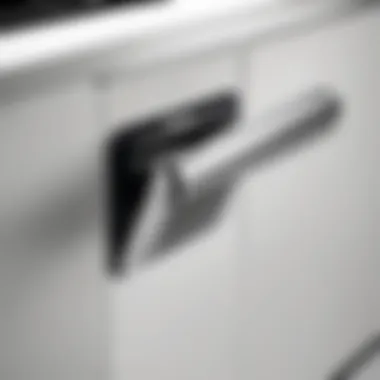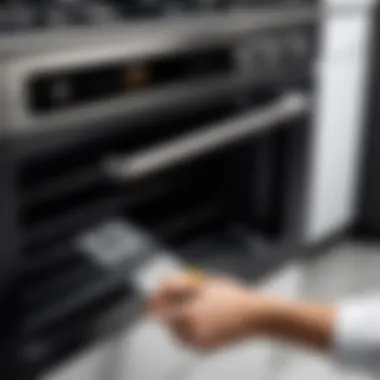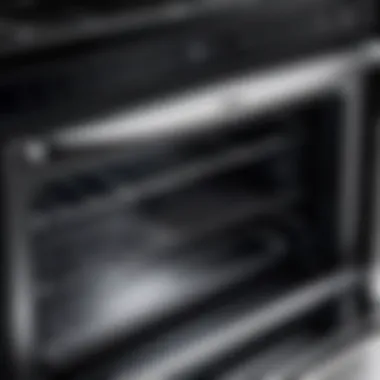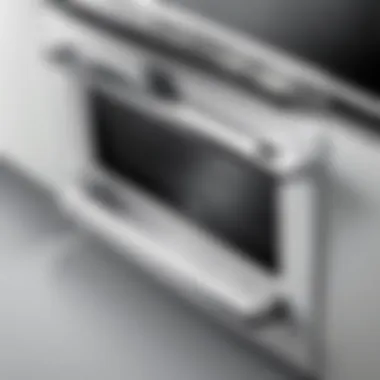Whirlpool Oven Door Handle Repair: A Comprehensive Guide


Intro
Repairing your Whirlpool oven door handle is not just about maintaining the appliance’s aesthetics. It plays a critical role in ensuring that the oven functions effectively and safely. A faulty handle can lead to problems, such as heat loss during cooking or even injury during use. This guide aims to empower users with the knowledge and strategies necessary to address handle issues, enhance their understanding of the appliance, and ensure its optimal performance.
In an era where DIY repairs can save time and money, having a robust understanding of the mechanics behind common problems can be invaluable. This article will guide you through the various aspects of oven door handle repair, touching on technical specifications, troubleshooting common problems, and offering practical solutions.
Technical Specifications
Detailed Product Specs
Whirlpool ovens are known for their durability and performance. Their door handles come in various designs and materials, including stainless steel, plastic, and composites. Knowledge of the specific type of handle on your model is crucial. Different models might have unique specifications, such as attachment methods or design intricacies.
Performance Metrics
Door handles must withstand repeated use and provide a secure grip. Understanding how much force is needed to open and close the oven door can help diagnose issues. The handle's performance can be affected by its material wear and tear, which may result from prolonged exposure to high temperatures.
Compatibility Information
When repairing or replacing the door handle, it is essential to ensure compatibility with your specific Whirlpool oven model. Not all handles are interchangeable, and using an incompatible part can lead to further damage or reduced functionality.
Common Problems With Door Handles
Identifying common issues can make repairs more manageable. Typical problems include:
- Loose handles: Often caused by worn screws or mounting brackets.
- Cracked plastic or broken metal: Frequent in older models and can render the handle unusable.
- Stripped screws: A common issue when screws are over-tightened.
Step-By-Step Repair Process
- Gather Tools: You will need a screwdriver, pliers, and possibly a replacement handle.
- Remove the Old Handle: Use the screwdriver to take off screws holding the handle in place. If the screws are stripped, pliers can help.
- Inspect the Mounting Bracket: Ensure that the bracket is not damaged. If it is, it also needs replacing.
- Attach the New Handle: Position it correctly and secure it with screws. Ensure a snug fit, but avoid over-tightening.
By following this step-by-step guide, you can ensure that your Whirlpool oven door operates effectively once more.
Final Thoughts
Repairing your Whirlpool oven door handle requires some basic technical knowledge and a desire to maintain your appliance's functionality. Whether you choose to tackle this task alone or seek professional help, you now have a better understanding of what is involved in the repair process. Keep this guide handy for future reference as you continue on your appliance maintenance journey.
Preface to Whirlpool Oven Handles
Oven door handles may seem like simple components of kitchen appliances, but they play a crucial role in their functionality and safety. Proper handling is essential not only for the performance of a Whirlpool oven but also for the overall cooking experience. A sturdy handle ensures that the door opens and closes easily, allowing access to the oven while managing heat effectively. When a handle is broken or malfunctioning, it can lead to a host of issues, including difficulty in opening the oven, improper sealing, or even potential burns due to steam or heat escaping.
Moreover, the convenience of using an oven hinges heavily on the ease of use, and the door handle is at the forefront of that interaction. Thus, understanding the nuances of oven handles can enhance the user experience. It is vital to maintain these components and recognize when they require service or replacement, which ultimately contributes to the longevity of the appliance itself.
In this article, we will explore the various aspects of Whirlpool oven door handles, focusing on the importance of these components and the common issues that may arise. Through an in-depth analysis, we aim to equip users with the knowledge needed to effectively troubleshoot and repair their oven handles, ensuring optimal performance and safety.
Importance of the Oven Door Handle
The oven door handle serves several important functions. Firstly, it acts as the primary point of interaction between the user and the oven. A functional handle facilitates quick access to the cooking space. Secondly, a reliable handle ensures that the door secures tightly during operation, maintaining consistent temperatures within the oven. If the handle is damaged or loose, the oven may not reach the set temperature effectively.
Additionally, a robust handle supports safety precautions while cooking. Ovens generate significant heat, and a faulty handle can compromise the user’s ability to operate the door safely, which might lead to burns or accidents. Therefore, ensuring that the oven door handle is both functional and secure is an important responsibility for any oven user.
Common Issues with Oven Door Handles


Oven door handles can encounter various issues over time. Some of the most common include:
- Cracks or Breaks: The plastic or metal that makes up the handle can crack due to drops, excessive force, or general wear and tear.
- Loose Handles: Screws may loosen over time, leading to instability and difficulty in operating the oven door.
- Corrosion: For metal handles, exposure to heat and moisture can result in rust or corrosion, compromising both function and aesthetics.
- Dirt Accumulation: Grime can build up around the handle, making it slippery and potentially hampering grip.
Recognizing these issues early on can prevent more serious problems from developing. Paying attention to the handle's condition and taking the necessary steps to maintain it can enhance the longevity and performance of the Whirlpool oven.
"An informed user is better equipped to maintain their appliance, leading to prolonged usability and safety."
Identifying Handle Problems
Repairing a Whirlpool oven door handle starts with identifying the problems that may affect its functionality. This crucial step ensures that you effectively address the specific issues, whether they are minor or more significant. Recognizing these aspects can help prevent further damage and enhance your overall experience with the appliance.
Signs of a Faulty Door Handle
Several indicators point to a malfunctioning oven door handle. Being aware of these signs can save time and resources. Common symptoms of a faulty door handle include:
- Loose Handle: If the handle feels wobbly or does not return to its original position, there may be a loose screw or a broken mechanism.
- Cracks or Breaks: Visible damage to the handle itself, such as cracks or missing pieces, suggests that repair or replacement is necessary.
- Difficulty Opening or Closing: If the handle requires excessive force to operate, this may indicate internal issues.
It is important to check these signs regularly. This practice can ensure that you notice issues early, which may prevent further complications.
Understanding the Mechanism of Door Handles
To effectively repair a door handle, one must understand its construction and function. A Whirlpool oven door handle typically consists of a few key components:
- Mounting Bracket: This part attaches the handle to the oven door.
- Handle Grip: This is the part you hold onto when opening or closing the oven.
- Internal Mechanism: These parts interact with the latch and hinge system to ensure smooth operation.
To assess any issues, familiarize yourself with these components. This knowledge will aid in diagnosing problems correctly.
Repairing a handle without understanding its mechanism may result in temporary fixes or additional damage. It is advisable to approach this task with a clear strategy and knowledge.
Tools Required for Repair
In the realm of appliance maintenance, proper tools can significantly ease the process. Specifically, for Whirlpool oven door handle repair, having the right equipment is essential. It not only ensures efficient handling of the repair but also minimizes the risk of mistakes or additional damage. Using inadequate or incorrect tools can lead to inefficiencies, extended repair times, and potential frustration. Therefore, understanding the tools required is a foundational step in the repair process.
A well-prepared toolkit creates a smoother workflow. It leads to a greater chance of achieving a successful repair. Furthermore, many of these tools are commonly found in most home toolkits, making it convenient for the average DIYer. Below, we will explore the basic tools needed, along with some specialized tools for more complex repairs.
Basic Tools Needed
When beginning your repair, it's vital to gather basic tools. These tools serve as the building blocks for most home repairs and are quite essential for this task. Here are some of the basic tools you will need:
- Screwdrivers: Both Phillips and flathead screwdrivers are crucial. They help in removing screws that secure various components of the oven door handle.
- Pliers: A pair of pliers can assist in gripping smaller parts or removing stubborn screws that are difficult to handle with fingers alone.
- Wrench or Socket Set: Depending on the model, some handles may require specialized wrenches for bolts.
- Utility Knife: This can be useful if you need to cut away any tape or seals that might obstruct access.
- Work Gloves: Protect your hands from sharp edges or hot surfaces during the repair.
- Flashlight: Good lighting is key, especially when working in tight spaces or poorly lit areas.
These basic tools ensure that you can effectively access and assess the door handle. They make the repair process straightforward, reducing the time and complications often associated with appliance maintenance.
Specialized Tools for Advanced Repairs
Sometimes, basic tools are insufficient to address deeper issues that may arise during the repair of the oven door handle. In these cases, specialized tools become necessary. Here are a few examples:
- Torque Wrench: For specific models, a torque wrench helps in applying precise tension to screws and bolts. This ensures that parts are securely positioned without over-tightening, which can lead to further issues.
- Digital Multimeter: If electrical components are involved, a digital multimeter aids in diagnosing electrical faults and ensuring all connections are functioning properly.
- Heat Gun: Occasionally, heat is needed to soften adhesives or plastic parts. A heat gun is especially useful when dealing with stubborn components that need extra attention.
- Rivet Gun: Some handles may be secured with rivets that require a rivet gun for removal or replacement.
Specialized tools require a deeper understanding and maybe a slight learning curve. Therefore, it is essential to explore their use before attempting repairs. By having these tools on hand, you can confidently tackle more complex challenges associated with your Whirlpool oven door handle repair.


Step-by-Step Repair Process
The process of repairing a Whirlpool oven door handle requires a methodical approach. Each step is vital to ensure that repairs are effective and long-lasting. Understanding how to tackle the repair not only saves time but also can prevent further damage to the appliance. Here we explore the specific steps involved in this repair process.
Assessing the Damage
Before any repairs can commence, it is necessary to assess the damage to the door handle. This assessment allows for a clear understanding of what is wrong and whether repairs are feasible or if replacement is required. Signs of damage could include a cracked handle, loose fittings, or internal mechanism failures.
- Visual Inspection: Look for any visible cracks or bends. Sometimes the issue is straightforward to diagnose.
- Testing Functionality: Open and close the door gently. If the handle feels loose or wobbly, more severe internal damage might exist.
By carefully evaluating the handle's condition, one can determine whether to repair or proceed with a replacement.
Dismantling the Door Handle
Once the damage has been assessed, the next step is dismantling the door handle. This phase is crucial to gain access to the internal components that may require repair or replacement.
- Preparation: Turn off the oven and unplug it for safety. Gather all necessary tools like screwdrivers and pliers.
- Removing Screws: Locate and remove any screws that secure the handle. This might require different sizes of screwdrivers, so ensure you have a complete set available.
- Gently Detach Handle: After unscrewing, gently pull the handle away from the oven door.
Taking note of the order of removal will be helpful during reassembly. Keeping all parts organized helps prevent loss or confusion later.
Repairing or Replacing Components
In this step, focus is on determining which components are salvageable and which need replacement. The options depend on the assessment previously conducted.
- Damaged Parts: Inspect all components for wear or damage. If any parts are beyond repair, sourcing replacements is essential.
- Cleaning: Sometimes components suffer from dirt buildup, causing functionality issues. Cleaning could restore them to usable condition.
- Replacement Parts: If a replacement is needed, ensure to select only compatible parts for your model of Whirlpool oven. Manufacturers often have specific part numbers.
This phase will require attention to detail. Ensure everything is functioning correctly before proceeding.
Reassembling the Handle
Once repairs or replacements are complete, it is time to reassemble the handle. Proper reassembly is equally important; otherwise, all efforts can go to waste.
- Follow Original Order: Reattach components in the reverse order of removal, referring to any notes taken during dismantling.
- Tighten Screws: Ensure that all screws are tightened securely but take care not to overtighten, as it may lead to further damage.
- Check Alignment: Make sure the handle is aligned properly. Misalignment can hinder function and potentially cause more wear.
Taking time to reassemble correctly leads to a reliable and sturdy handle, ready for regular use.
Testing the Repair
Testing the repair is a crucial step in the process of fixing your Whirlpool oven door handle. After completing all the repair actions, it is essential to ensure functionality and safety. This not only assures you that the handle is working as intended, but also prevents potential hazards that could arise from improper installation or unresolved issues. Effective testing allows for immediate identification of any lingering problems.
Performing a Functionality Test
To start, you should conduct a functionality test to verify that everything is working correctly. Begin by gently opening and closing the oven door. Pay attention to how smoothly the door operates. It should not wobble or require excessive force. A properly functioning handle should respond easily to a light pull and should return to its resting position without delay.
During this test, check for any unusual sounds that might indicate a mechanical issue. If the handle feels loose or rattles, it may need further adjustment. Take note of its performance during this initial test, as this will help you determine if additional repairs or adjustments are needed.
Ensuring Safety and Stability
After confirming that the handle works correctly, the next step focuses on safety and stability. Inspect the handle attachment closely. Ensure that all screws are tightened adequately, as loose screws could cause the handle to detach during regular use, posing a risk of injury or damage to the oven.
Additionally, examine the handle itself for any signs of undue strain or structural damage. Look for cracks or warps that may not have been noticeable before. If any issues arise during this check, it is wise to consider replacing the handle entirely. This ensures that the oven door will function efficiently and safely during cooking tasks.


In summary, testing after a repair is not merely a formality but an essential part of the process that can save you a great deal of trouble later on. Regular testing of your repairs will lead to better maintenance of your appliances.
"Thorough testing after repairs guarantees the longevity and safe use of your Whirlpool oven."
By integrating these checks into your repair routine, you will enhance the reliability of your oven and ensure a safer cooking environment.
Preventative Maintenance
Preventative maintenance is critical for ensuring the longevity and functionality of the Whirlpool oven door handle. By engaging in regular maintenance, users can avoid more significant problems and costly repairs. It is about being proactive rather than reactive. Taking some simple steps can save time and increase the efficiency of your appliance.
Regular inspections of door handle integrity help identify subtle issues before they escalate. A loose or damaged handle may seem minor, but it can lead to bigger complications, such as complete breakage or even impact the oven's ability to seal properly during cooking. Additionally, ensuring that the handle is clean and free from debris can prevent wear and tear. These careful considerations contribute to the overall performance and safety of the appliance.
Regular Checks for Door Handle Integrity
Conducting regular checks for door handle integrity allows users to catch wear or damage early. It is recommended to perform a visual inspection at least once a month. Look for cracks, signs of wear, or misalignment. Testing the handle's stability by applying gentle pressure can also indicate if something is amiss. Here are some key aspects to consider during these checks:
- Inspect for cracks: Any visible damage could worsen over time.
- Evaluate stability: A firm handle should not wiggle or feel loose.
- Check mounting screws: Ensure that screws are tightened and not corroded.
If any issues are found during these checks, addressing them promptly will help maintain the handle's functionality.
Best Practices for Handling the Oven Door
How a user interacts with their oven door can greatly influence the lifespan of its handle. Implementing best practices when using the oven will lead to fewer repairs and enhancements in efficiency. Consider the following suggestions:
- Use with care: Always use the handle to open and close the oven door, avoiding pushing or pulling on the door itself.
- Avoid excessive force: Applying heavy pressure when closing the door can strain the handle.
- Keep it clean: Regularly cleaning the handle and surrounding areas helps avoid the buildup of grime which can hinder its function.
When to Seek Professional Help
In the realm of appliance maintenance, understanding when to call in a professional can save time, money, and potential mishaps. This section emphasizes the importance of discerning between manageable repairs and situations that require expert intervention. A crucial insight here is that not every issue with your Whirlpool oven door handle can be resolved by a DIY enthusiast.
Identifying Complex Issues
Even for those familiar with basic repairs, certain complications can arise that are beyond typical household capabilities. Instances include internal component failures that cannot be seen without dismantling the entire door handle mechanism. For example, if the handle is loose but appears undamaged, it may indicate a deeper issue within the internal assembly or even the door hinges.
Identifying these complexities is paramount. There are signs such as unusual noises during operation, the handle seemingly dislocated or not returning to its original position after use, and persistent malfunction after repair attempts. Generally, if you have attempted a repair and the issue persists, it is advisable to consult a professional to avoid exacerbating the problem.
Understanding Warranty Considerations
Another key aspect to take into account is the importance of warranty considerations. Many Whirlpool ovens come with a warranty that covers parts and labor for a specific time frame. Before embarking on self-repair, it's prudent to check your warranty status. Attempting repairs on your own can sometimes void this warranty, leaving you responsible for any future fixes or replacements that arise.
This gives rise to two main points:
- If your oven is relatively new, it might be wise to reach out to customer service for guidance or service without risking the warranty.
- Familiarize yourself with what is covered under your warranty. Understanding these fine details can prevent unnecessary costs and stress.
Closure
The conclusion of this guide is crucial as it encapsulates the essential insights on Whirlpool oven door handle repair. This process is not only about fixing a broken handle but also about maintaining the overall efficiency of your appliance. A sturdy and functional door handle ensures that the oven door closes properly, which is vital for optimal heat retention. If a handle is faulty, it could lead to inefficient cooking or potential safety hazards due to overheating or malfunction.
Summary of Repair Insights
Throughout this article, various aspects of repairing a Whirlpool oven door handle have been examined. The concepts covered include identifying common handle issues, the tools required for repair, and a detailed step-by-step repair process. Recognizing signs of wear and tear early can prevent more complex problems down the road. Additionally, we discussed the importance of safety checks following any repair to ensure the functionality of the oven is restored seamlessly. Proper maintenance is essential for extending the lifespan of your appliance, and this guide serves as a comprehensive roadmap for achieving that.
Encouragement for DIY Repair
There is significant value in attempting a DIY repair for your oven door handle. With the right tools and instructions, many users can successfully carry out repairs without needing professional help. This not only saves money but also fosters a deeper understanding of your appliance.
For individuals who enjoy hands-on projects or those who are technologically inclined, this guide demystifies the repair process. The satisfaction derived from completing a repair can be considerable. Always approach repairs with caution, but do not hesitate to explore this practical skill.
For online communities, resources like Reddit offer forums where individuals share their experiences and solutions related to appliance maintenance, which can be helpful for additional support and ideas.







